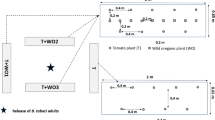Abstract
Examination ofHeliamphora heterodoxa andH. tatei from the Guayana Highlands of Venezuela reveals that the enol diacetal monoterpene, sarracenin, is the major volatile compound present in the spoon-shaped structures of leaves of the pitchers. In addition, erucamide, phenol, cinerone, phenylacetaldehyde, and a series of methyl esters also occur in extracts of the spoon-shaped appendages of pitchers at the time during which they attract insects.
Similar content being viewed by others
References
Brewer-Carias, C. 1972. Plantas carnivoras del Cerro de la Neblina.Def. Nat. 2:17–26.
Darwin, C. 1888. Insectivorous Plants, 2nd ed., John Murray, London.
Givinish, T.J., Burkhardt, E.L., Happel, R.W., andWeintraub, J.D. 1984. Carnivory in the bromeliadBrocchinia reducta with a cost/benefit model for the general restriction of carnivorous plants to sunny, moist, nutrient-poor habitats.Am. Nat. 124:479–497.
Gonzales, J.M., Jaffé, K., andMichelangeli, F. 1991. Competition for prey between the carnivorous BromeliaceaeBrocchinia reducta and SarraceniaceaeHeliamphora nutants.Biotropica 23:602–604.
Jaffé, K., Michelangeli, F., Gonzalez, J.M., Miras, B., andRuiz, M.C. 1992. Carnivory in pitcher plants of the genusHeliamphora (Sarraceniaceae).New Phytol. 122:733–744.
Joel, D.M., Juniper, B.E., andDafni, A. 1985. Ultraviolet patterns in the traps of carnivorous plants.New Phytol. 101:585–593.
Juniper, B.E., Robin, R.J., andJoel, D.M. 1989. The Carnivorous Plants. Academic Press, London.
Lloyd, F.E. 1942. The Carnivorous Plants. Chronica Botanica, Vol. 9. Ronald Press, New York.
Miles, D.H., Kokpol, U., andMody, N.V. 1975. Volatiles inSarracenia flava.Phytochemistry 14:845–846.
Miles, D.H., Kokpol, U., Bhattacharya, J., Attwood, J.L., Stone, K.E., Bryson, T.A., andWilson, C. 1976. Structure of sarracenin. An unusual enol diacetal monoterpene from the insectivorous plantSarracenia flava.J. Am. Chem. Soc. 98:1569–1573.
Mody, N.V., Henson, R., Hedin, P.A., Kokpol, U., andMiles, D.H. 1976. Isolation of the insect paralyzing agent coniine fromSarracenia flava.Experientia 32:829–830.
Nagura, T., Hayashi, S., andKato, M. 1992. Preparation of ink sheets for thermal transfer printer. Jpn. Kokai Tokkyo Koho JP 04, 101, 890 (C1. B41M5/40) (patent).
Radosta, J.A., andRiley, W.D. 1991. Treated talc as an effective anti-block for LDPE blown film.Ann. Tech. Conf. Soc. Plast. Eng. 49:1351–1354.
Rymal, D.E., andFolkerts, G.W. 1982. Insects associated with pitcher-plants (Sarracenia: Sarraceniaceae), and their relationship to pitcher-plant conservation.J. Ala. Acad. Sci. 53:131–151.
Author information
Authors and Affiliations
Rights and permissions
About this article
Cite this article
Jaffé, K., Blum, M.S., Fales, H.M. et al. On insect attractants from pitcher plants of the genusHeliamphora (sarraceniaceae). J Chem Ecol 21, 379–384 (1995). https://doi.org/10.1007/BF02036725
Received:
Accepted:
Issue Date:
DOI: https://doi.org/10.1007/BF02036725




